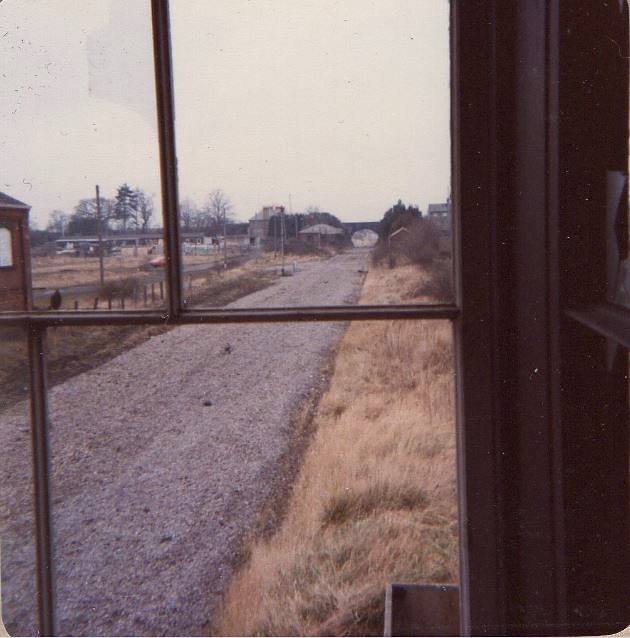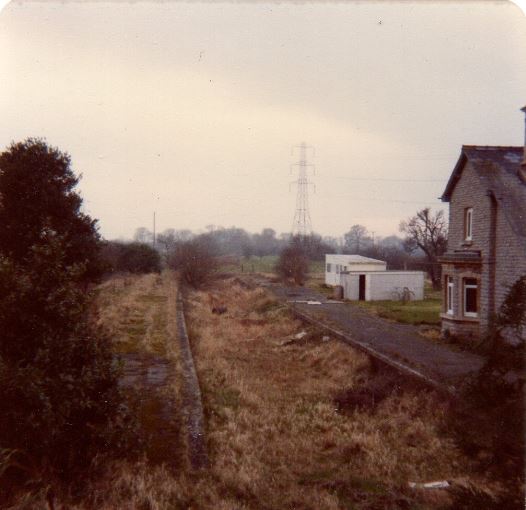During 1980 I started a series of explorations of disused railways with my friend Alan W. He had already looked at some old lines and the opportunity to repeat those and do even more was very appealing to say the least. We would decide on the railway, get the relevant OS maps, and choose a day, hoping the weather would hold up because it inevitably meant taking a day's leave from work. Then on the day it would be a drive to the start point, and then during the course of the day visiting interesting locations that we had identified on the maps - a long embankment or cutting, viaduct, tunnel, station site, etc, etc. All the time of course we were aware that access to the old line would not always be easy and often sections of trackbed had gone into private ownership or had been built over.
Over the course of about two years explorations were made of: -
MSWJR (a day trip from north of Andover back to Chedworth, plus numerous other occasions walking sections between Charlton Kings, Cheltenham and Chedworth/Fosse Cross, and also the Cotswold Water Park section - Cricklade to South Cerney),
Andoversford - Kingham - Hook Norton (a day trip on the Cheltenham-Banbury line)
Kemble - Cirencester and Kemble - Tetbury branches
Great Central (a day trip from north of Aylesbury to south of Rugby)
S&DJR (a two day trip from Midford to Broadstone Junction, plus two other occasions, one of which included the Devonshire Bank out of Bath)
Fairford Branch
********************
Then in 1982 I joined Cheltenham Rambling Club and, during walks over the successive years, explorations of the old Forest of Dean railways proved to be very interesting, and parts of some of the previously mentioned lines were again covered and more photos taken. During one weekend away with the Club, we walked some of the Tissington Trail in Derbyshire.
A holiday in Scotland in 1989 included a walk up the Glen Ogle line featured in TV programmes by Julia Bradbury and recently by Rob Bell. I can certainly confirm that the viaduct that impressed both of them is quite something. Similarly sections of the Lynton and Barnstaple Railway walked in 1985/86 were fascinating. In a previous blog article I described walks done in September last year along the Padstow - Wadebridge - Wenford lines.
So often with some of these railways it was hard to believe that trains had once used them, so overgrown were some of the sections. This particularly applied to the single track main lines where the thought that double-headed 12 coach trains had once traversed them was quite staggering.
However, there was one line which stood out above all the others with the statement, "Here was once a major railway". That was the Great Central.
Taken in October 1980, this is Helmdon Bridge (bridge 519), just a short way south of the station site and village, and a few miles north of Brackley. It was all still the same when I visited it again in 2018. No doubts about this being a main line. It's tragic that the GC was closed in 1966 - what a bonus it would have been for HS2 !
Now, 40 years later, many sections of the lines we explored between 1980 and 1982, and afterwards in my years with the rambling club, would no longer be accessible.
However, I can still enjoy my old hobby. Living near Stroud, there are the cycle trails along the old Midland Railway Stonehouse - Stroud / Nailsworth branches. It's surprising how many features and artifacts still survive along them.
******************
So, back to the 26th January 1981 and the Honeybourne Line before any new track had been laid by our newly formed GWSR.
The track had not long been taken up by BR (this began in 1979) as shown by the clean layer of ballast and very prominant sleeper indentations.
High Street Bank, Cheltenham looking towards the former junction with the line to St James Station and in the distance the very prominent tower of Christ Church.
There is an excellent photograph of the same view taken from the footplate of 2-8-0 3840 with a Banbury-Cardiff train that had been held by the home signal at this point. This is in an excellent article describing a footplate ride of the whole journey ("Ironstone to Cardiff" by R.J.Doran in Trains 'sixtyeight, published by Ian Allan in 1967. If anyone is interested in reading this, Amazon have a number of secondhand copies available).
A closer view taken by Alan.Just a short way north, another shot taken by Alan looking north.The north portal of Hunting Butts Tunnel. Eventually it would be full of old freight vehicles awaiting restoration.Looking north towards Cheltenham Racecourse Station.Racecourse Station looking south. I wonder what I would have thought had I known that about 30 years later I would be standing at this spot during a very enjoyable "Fire-and-drive" day with Foremarke Hall.Looking north at Gotherington Halt, now the home of Bryan Nicholls and Savita Patel, and their wonderful collection of railwayana.
*******************
Our next stop was Greet, just outside Winchcombe. I can't remember exactly where we parked the car - in the station yard? Winchcombe Station had of course been completely removed.
I look upon the next moment with great regret.
Looking north towards Toddington we could see the old goods shed. Why did we not walk up to it or even take a photo of it?. Maybe it was the lorry parked behind and we had no wish to prompt any unwelcome response. Whatever, we decided to explore the tunnel instead.
A number of years ago while perusing the Web I came across what in effect is the photo I should have taken. There was no identity as to who had taken it and I have never been able to find it since. It was probably taken at about the same time.
Nearly 30 years later (I became a volunteer in late 2007) this
was to become practically my second home and I was to learn that previously the building had been
rented out by BR to a firm that crushed fruit stones for cleaning products (soaps, etc), and in effect the reason it survived when everything else had been cleared away.
So we headed under the road bridge and the cutting towards Greet Tunnel.

The north portal. The tunnel is on a curve and in the middle almost all vision had gone.
Approaching the south portal. 30 years on and I would be walking through here a number of times, on one occasion to retrieve a dropped coach dynamo belt and, sad to say, one of the tiny compartment shelves that had probably come loose and been thrown out of the coach window (our Permanent Way team had tipped us off).
Our next call was at Hayles. Looking south, who would have thought that a new halt would one day be built here, just behind where Alan is standing.
Arriving at a very quiet Toddington. Now who is that in the signalbox?
None other than Alan working the original frame.
The view north from the signalbox with the old goods shed on the left, the station (minus platform edging), and what will become our car park and location of the Flag & Whistle restaurant.
A zoomed view looking north. Apologies for the lack of clarity - I'm afraid my camera was just an Instamatic (the vastly better 35mm Olympus OM10 was purchased 2 years later).Was the Garden Centre up and running then? The buildings are there.
The signalbox looking south.Well, there's always one, isn't there! Toddington looking south. Judging by the clarity of the indentations in the ballast, you felt as though the track had been removed the day before!We then walked north to see Stanway Viaduct with another look back towards Toddington Station.
Looking north across the viaduct - there appears to be a very deep layer of ballast.
Again looking north along the west side of the viaduct.
I don't know why we didn't look at Broadway. Our next stopping point was Weston-sub-Edge. This was the view south.
Weston-sub-Edge Halt, looking north.
Approaching Honeybourne with the track and signal still in place.

Looking north under the roadbridge.The final photo of the day, standing beneath the Cotswold Line, with the lines to the left heading towards Stratford and those on the right the spur to Honeybourne Station.
It had been a good day and not cold despite being January.
However it wasn't quite the end of our explorations. On the way back to Cheltenham we had a quick look at a bit of the Ashchurch-Evesham line with photos taken at Ashton-under-Hill Station and Beckford.
Ashton-under-Hill Station looking west - it was good to see so much left.
The remains of the trackbed looking towards Ashchurch, taken from the overbridge at Beckford.And the next trip? Two months later exploring the Fairford Branch, but for some reason only five photos taken. There lies another mystery too long ago to recall.
***********************
In a way Alan and I were fortunate in that we explored disused railways often not that long after they had been closed. The one with the shortest time being of course the Honeybourne line. Others like the GCR and S&D were about 14-15 years since closure, the MSJWR varied from about 16-20 years depending on where you explored (the Ludgershall-Andover section was still in place and even now may still exist). In actual fact it wasn't so much when closure happened, but when the track was actually taken up and associated equipment removed.
In addition to the various TV programmes, a number of books have been produced on exploring disused railways, probably one of the best being "Through Great Central England" by David Ablitt (Silver Link Publishing 2009). He had done his exploration just a few years after Alan and I, and even in that short time changes had occurred. Another good read is "A Walk Along the Tracks" by Hunter Davies (Weidenfeld and Nicolson 1982).
Finally on YouTube a number of enthusiasts have produced whole series of videos very much in line with what Alan and I did. Just exploration, without the meeting and greeting that you get with the TV programmes, where sometimes it's nearly all chat and disappointingly very little exploration is actually done!











































































